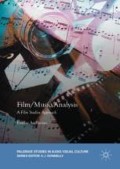Abstract
Some recent proposals are examined that have tried to move from a separatist conception (music and visuals are seen as separate entities) to a non-separatist conception (music and visuals are equal part in the audiovisual product), and others that have tried to build a bridge between Music Studies and Film Studies to find a common ground to tackle film music. The pros and cons of each proposal are articulated.
Access this chapter
Tax calculation will be finalised at checkout
Purchases are for personal use only
References
Abbate, Carolyn. 1991. Unsung Voices: Opera and Musical Narrative in the Nineteenth Century. Princeton, NJ: Princeton University Press.
Altman, Rick. 2000. Inventing the Cinema Soundtrack. Hollywood’s Multiplane Sound System. In Music and Cinema, ed. James Buhler, Caryl Flinn, and David Neumeyer, 339–359. Hanover, NH: Wesleyan University Press.
Bordwell, David. 1980. The Musical Analogy. Yale French Studies 60: 141–156.
Bordwell, David. 1981. The Films of Carl-Theodor Dreyer. Berkeley and Los Angeles: University of California Press.
Bordwell, David. 1996. Contemporary Film Studies and the Vicissitudes of Grand Theory. In Post-Theory. Reconstructing Film Studies, ed. David Bordwell and Nöel Carroll, 3–36. Madison, WI: University of Wisconsin Press.
Bordwell, David. 2008. Poetics of Cinema. New York and London: Routledge.
Bordwell, David, and Kristin Thompson. 2010. Film Art. An Introduction, 9th ed. New York: McGraw and Hill.
Bordwell, David, and Noël Carroll. 1996. Introduction. In Post-Theory. Reconstructing Film Studies, ed. David Bordwell and Noël Carroll, xiii–xvii. Madison, WI: University of Wisconsin Press.
Branigan, Edward. 1992. Narrative Comprehension and Film. New York: Routledge.
Carroll, Noël. 1988. Mystifying Movies: Fads and Fallacies in Contemporary Film Theory. New York: Columbia University Press.
Chion, Michel. 1994. Audio-Vision. Sound on Screen [1990], trans. Claudia Gorbmam. New York: Columbia University Press.
Choe, Chong S., Robert B. Welch, Robb M. Gilford and James F. Juola. 1975. The “Ventriloquist Effect”: Visual Dominance or Response Bias? Perception & Psychophysics 18 (1): 55–60.
Cook, Nicholas. 1998. Analysing Musical Multimedia. Oxford: Clarendon Press.
Cooper, Grosvenor, and Leonard B. Meyer. 1960. The Rhythmic Structure of Music. Chicago: University of Chicago Press.
Donnelly, K.J. 2014. Occult Aesthetics: Synchronization in Sound Film. Oxford and New York: Oxford University Press.
Frampton, Daniel. 2006. Filmosophy. Chichester and New York: Wallflower-Columbia University Press.
Heldt, Guido. 2013. Music and Levels of Narration in Film. Steps Across the Border. Bristol: Intellect.
Jacobs, Lea. 2014. Film Rhythm after Sound: Technology, Music, and Performance. Berkeley, CA: University of California Press.
Kalinak, Kathryn. 1992. Settling the Score. Music and the Classical Hollywood Film. Madison, WI: University of Wisconsin Press.
Kassabian, Anahid. 2001. Hearing Film: Tracking Identification in Contemporary Hollywood Film Music. New York and London: Routledge.
Kulezic-Wilson, Danijela. 2015. The Musicality of Narrative Film. Basingstoke: Palgrave MacMillan.
McGurk, Harry, and John MacDonald. 1976. Hearing Lips and Seeing Voices. Nature 264 (December): 746–748.
Middleton, Richard. 1990. Studying Popular Music. Buckingham: Open University Press.
Nagari, Benjamin. 2016. Analytical Psychology and Music in Film. Hove and New York: Routledge.
Nasta, Dominique. 1991. Meaning in Film: Relevant Structures in Soundtrack and Narrative. Berne and Berlin: Peter Lang.
Neumeyer, David. 2015. Meaning and Interpretation of Music in Cinema. Bloomington and Indianapolis: Indiana University Press.
Prendergast, Roy M. 1977. Film Music: A Neglected Art: A Critical Study of Music in Films. New York: W. W. Norton.
Redner, Gregg. 2011. Deleuze and Film Music. Building a Methodological Bridge Between Film Theory and Music. Bristol: Intellect.
Smith, Jeff. 2009. Bridging the Gap: Reconsidering the Border Between Diegetic and Nondiegetic Music. Music and the Moving Image 2 (1): 1–25.
Sobchack, Vivian. 1992. The Address of the Eye: A Phenomenology of Film Experience. Princeton, NJ: Princeton University Press.
Sobchack, Vivian. 2011. Phenomenology. In The Routledge Companion to Philosophy ad Film, ed. Paisley Livingston and Carl Plantinga, 435–445. Abingdon and New York: Routledge.
Thompson, Kristin. 1988. Breaking the Glass Armor: Neoformalist Film Analysis. Princeton, NJ: Princeton University Press.
Thomson-Jones, Katherine. 2011. Formalism. In The Routledge Companion to Philosophy and Film, ed. Paisley Livingston and Carl Plantinga, 131–141. Abingdon and New York: Routledge.
Walker, Elsie. 2015. Understanding Sound Tracks Through Film Theory. Oxford and New York: Oxford University Press.
Wierzbicki, James. 2009. Film Music: A History. Abingdon and New York: Routledge.
Winters, Ben. 2010. The Non-Diegetic Fallacy: Film, Music, and Narrative Space. Music & Letters 91 (2): 224–244.
Winters, Ben. 2012. Musical Wallpaper? Towards an Appreciation of Non-narrating Music in Film. Music Sound and the Moving Image 6 (1): 39–54.
Author information
Authors and Affiliations
Corresponding author
Rights and permissions
Copyright information
© 2017 The Author(s)
About this chapter
Cite this chapter
Audissino, E. (2017). Recent Attempts to Bridge the Gap and Overcome a Separatist Conception. In: Film/Music Analysis. Palgrave Studies in Audio-Visual Culture. Palgrave Macmillan, Cham. https://doi.org/10.1007/978-3-319-61693-3_3
Download citation
DOI: https://doi.org/10.1007/978-3-319-61693-3_3
Published:
Publisher Name: Palgrave Macmillan, Cham
Print ISBN: 978-3-319-61692-6
Online ISBN: 978-3-319-61693-3
eBook Packages: Literature, Cultural and Media StudiesLiterature, Cultural and Media Studies (R0)

